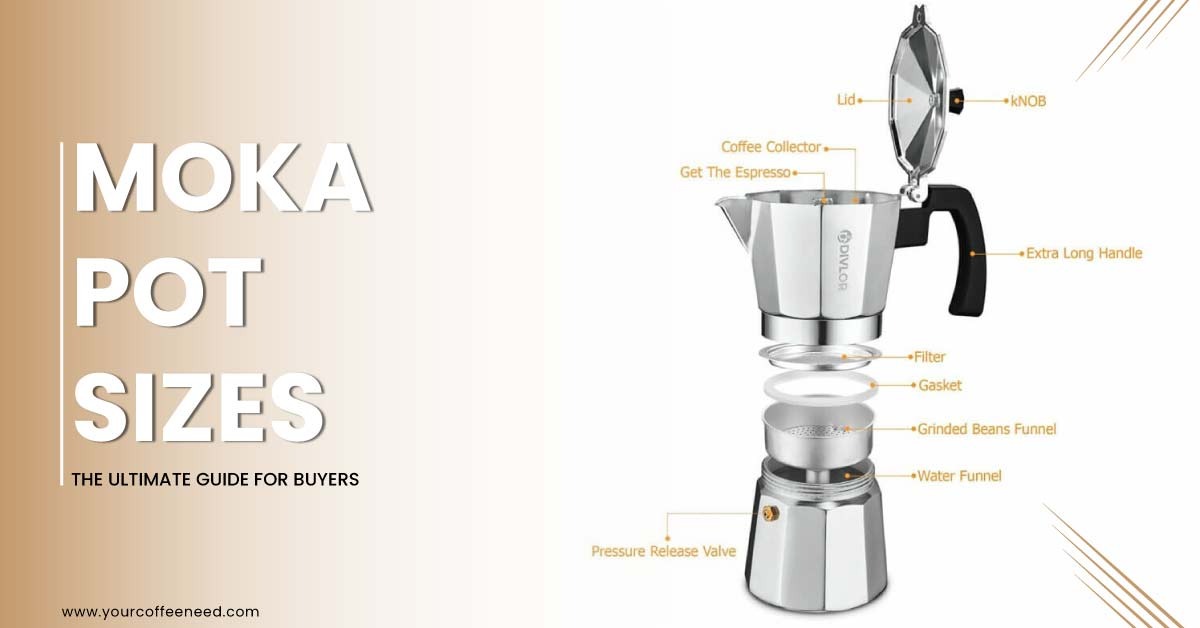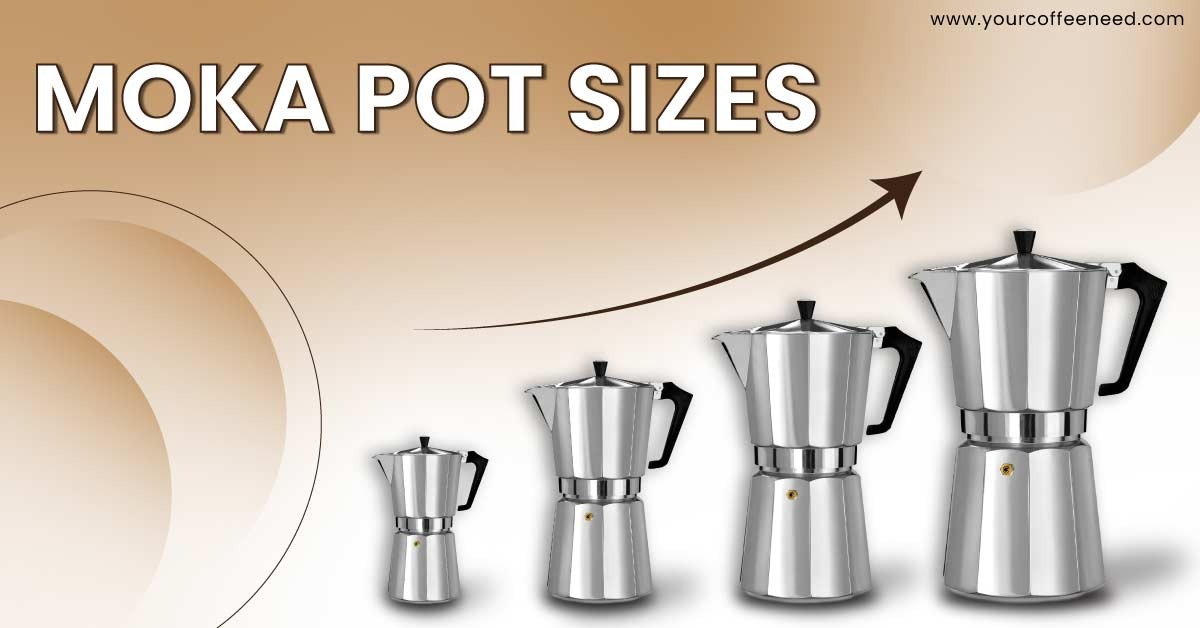Coffee pot sizes can play a significant role in one’s daily routine and overall coffee experience.
With the growing popularity of speciality coffee, individuals often find themselves grappling with the various options available in the market.
Understanding the different coffee pot sizes and their impact on the brewing process is essential for any coffee enthusiast.
From small personal pots to larger ones catering to groups, selecting the right size has the potential to enhance the freshness, flavour, and aroma of brewed coffee.
The size of coffee pots varies depending on factors like brewing method, material, capacity, and functionality. As consumers navigate through these possibilities, being informed about coffee pot sizes and their effects on coffee quality can greatly assist in making the best choice for individual or communal needs.
A wide range of coffee pot sizes caters to the diverse preferences of coffee drinkers. Whether it be a compact pot for a single serving or a more substantial vessel to accommodate the morning caffeine needs of an entire household, understanding capacity and brewing mechanics is key to maximizing enjoyment.
This exploration of moka pot sizes seeks to shed light on the various options and guide the discerning coffee drinker toward their ideal choice.
Standard Coffee Pot Sizes
When it comes to coffee pot sizes, there is a broad range catering to the needs of various individuals and groups.
In general, coffee pots come in different sizes, measured in terms of the number of cups they can hold. It is essential to understand that a “cup” in this context refers to a standard 5-ounce (150-milliliter) serving size.
A popular option among coffee drinkers is the 12-cup coffee maker, which is ideal for families or gatherings. This size allows for brewing an ample amount of coffee to serve multiple people at once. Typically, a 12-cup coffee maker satisfies the caffeine requirements for 6 to 12 people, depending on individual preferences and cup sizes.
Single cup coffee makers have gained popularity in recent years, offering a convenient option for those who prefer personalized coffee experiences. These machines are perfect for individuals living alone or in shared spaces where brewing an entire pot is not feasible. A single cup coffee maker typically brews between 6 to 12 ounces of coffee, depending on user preferences.
For smaller households or workplaces, coffee pot sizes ranging from 4 to 8 cups are also available. These mid-range sizes cater to the needs of 2 to 5 people, offering a compromise between convenience and efficiency.
In summary, coffee pots are available in a wide array of sizes to accommodate various scenarios and preferences. Whether serving a single person or a group, there is a coffee pot size that fits the bill.
The primary consideration when choosing a coffee pot size is the number of people it will serve and the desired brewing capacity.
Moka Pot Sizes
Moka pots come in various sizes, designed to accommodate the needs of different coffee drinkers.
In this section, we will explore 1-cup, 3-cup, 6-cup, and 12-cup Moka pots, discussing their brewing process and the amount of coffee each can produce.

1-Cup Moka Pot
A 1-cup Moka pot is ideal for single servings of coffee. It typically holds around 30 milliliters (1 ounce) of brewed coffee. To use this size, begin by adding cold water to the base, filling it up to the safety release valve. Add finely-ground coffee to the filter without pressing down, and place it onto the base. Finally, screw on the top chamber at medium heat, and allow for the brewing process to take place.
3-Cup Moka Pot
The 3-cup Moka pot has the capacity to brew approximately 90 milliliters (3 ounces) of coffee, enough for three servings. Using this pot size is similar to the 1-cup version, with the process taking place at a medium heat as well.
6-Cup Moka Pot
For families or small gatherings, the 6-cup Moka pot is a popular choice. This pot size can produce around 180 milliliters (6 ounces) of coffee. As with the other sizes, brewing with a 6-cup Moka pot requires the same method: filling the base with water, adding finely-ground coffee to the filter, and placing the pot on medium heat.
12-Cup Moka Pot
A 12-cup Moka pot is the largest option and can yield approximately 360 milliliters (12 ounces) of coffee – suitable when serving larger groups of people. Using a larger Moka pot follows the same brewing process with the water, coffee, and medium heat.
In conclusion, selecting the best Moka pot size depends on the individual’s preferences and the number of cups desired.
Each size offers a different amount of coffee, ranging from a single serving to multiple cups for larger gatherings.
The larger the pot, the more coffee it can produce, making it essential to choose the right size for your coffee consumption needs.
Stovetop Espresso Makers
Stovetop espresso makers are a popular way to make delicious espresso at home. They come in various sizes and materials, such as stainless steel and aluminum, which each have their unique characteristics.
In this section, we will discuss the differences between these two types of stovetop espresso makers.
1. Stainless Steel
Stainless steel stovetop espresso makers are durable, corrosion-resistant, and often compatible with both gas and induction stoves. They are a good choice for those who have an induction stove, as not all aluminum models are induction-compatible. One drawback of stainless steel espresso makers is that they can be a bit more expensive than their aluminum counterparts. However, they tend to last longer and maintain their appearance better over time.
Some popular stainless steel stovetop espresso makers include:
- Bialetti Moka Express: This iconic espresso maker is known for its quality and ease of use. It features a safety valve to ensure proper pressure, and its stainless steel construction is ideal for induction stovetops.
2. Aluminum
Aluminum stovetop espresso makers are more affordable and lightweight compared to their stainless steel counterparts. They offer excellent heat conduction for quick espresso making, but may not be compatible with all induction stovetops due to their material. Additionally, aluminum espresso makers require more careful cleaning, as they can corrode if not properly maintained.
Despite these drawbacks, aluminum stovetop espresso makers remain a popular choice for many coffee lovers. Some models to consider include:
- Bialetti Moka Express: This classic espresso maker is also available in aluminum and boasts the same easy-to-use design and safety valve as the stainless steel version. However, it may not work with all induction stovetops.
In summary, when choosing a stovetop espresso maker, consider your budget, stove type, and maintenance preferences.
Both stainless steel and aluminum models offer unique benefits, but the right choice ultimately depends on your priorities and needs.
Measurement Guidelines
Coffee-to-Water Ratio
When brewing coffee, it is important to use the correct coffee-to-water ratio for the best results. For a standard cup of coffee, the ideal ratio is 1:15 or 1:18, which translates to 1 gram of coffee per 15-18 milliliters (or approximately 0.5-0.6 fluid ounces) of water.
- For moka pot coffee, the coffee-to-water ratio is slightly different, typically around 1:10.
- For espresso cups, the ratio is much stronger, close to 1:4.
To determine the proper coffee and water quantities for your coffee pot, consider the following:
- Measure your coffee scoop or use a digital scale to weigh the allotted grams of coffee.
- Fill your coffee pot’s filter basket with the measured coffee grounds.
- Add cold water to the pot, measuring in fluid ounces or milliliters.
Determining Cup Size
The cup coffee pot defines a “cup” differently than standard U.S. measurements.
One cup is often equal to 4-6 fluid ounces instead of 8 fluid ounces.
Here is a table depicting the measurements in both ounces and millimeters:
| Size | Fluid Ounces | Millimeters |
|---|---|---|
| Small Espresso Cup | 1.0 – 1.5 | 30 – 45 |
| Large Espresso Cup | 2.0 – 3.0 | 60 – 90 |
| Traditional Coffee Cup | 4.0 – 6.0 | 120 – 180 |
For the size of your moka pot, use the following guidelines:
- Most common sizes are designed to produce a set number of cups of coffee (usually 1, 3, 6, 9, or 12 cups).
- One moka pot cup is usually equivalent to 1.5-2 ounces of coffee or 45-60 milliliters.
- To find the right moka pot size, simply multiply the number of moka cups desired by the ounces per cup.
For example, a 6-cup moka pot would produce 9 -12 fluid ounces of coffee (270-360 milliliters). Be aware that using less water than the intended capacity may result in a stronger brew.
Measure the coffee and water accurately to ensure consistent, great-tasting coffee.
Selecting the Right Size
Coffee Consumption Frequency
To choose the right size for your coffee pot, first consider how often you consume coffee.
For coffee lovers who enjoy multiple cups daily, a larger pot is a great option. It allows for brewing larger quantities of your favorite drink without the need to frequently refill the coffee grounds and hot water.
On the other hand, if you only indulge in a daily perfect cup of coffee or even less frequently, a smaller pot is a more suitable choice. Smaller sizes are not only space-efficient but also allow you to prepare fresh, delicious coffee each time.
Number of Coffee Drinkers
Another crucial factor to consider is the number of people in your household who drink coffee.
To ensure there is enough to satisfy everyone, use the following guidelines:
| Number of Coffee Drinkers | Moka Pot Cup Size | Espresso Machine Size |
|---|---|---|
| 1-2 | 2-4 cups | Single or double shot |
| 3-4 | 6-9 cups | Double or triple shot |
| 5+ | 10+ cups | Commercial size |
Keep in mind that different brewing methods, like using a Moka pot or an espresso machine, require different pot sizes.
Moka pot size matters because its upper chamber determines the strength and volume of the coffee, while espresso machines use a different ratio due to extraction pressure.
To achieve the golden ratio for coffee brewing, make sure you have the right balance between coffee beans, ground coffee, and brewing method.
The best size will vary based on individual preferences and brewing methods, but understanding coffee consumption frequency and the number of coffee drinkers will help guide your decision in selecting the appropriate pot size.
Additional Brewing Methods
In the world of coffee, there are various brewing methods to suit different tastes and preferences. Let’s explore a few popular ones, such as drip coffee makers, French press, and moka pots, to understand how they impact the coffee’s flavor and strength.
Drip coffee makers are a common choice for many households and coffee shops due to their convenience and ability to brew large quantities. In this method, water is heated and dripped through a coffee filter containing ground coffee. The brewed coffee is then collected in a coffee pot. This process results in a smooth, clean, and delicious cup of coffee. Depending on the size of your drip coffee maker, you can easily adjust the coffee-to-water ratio to customize the strength of your coffee.
French press is another popular brewing method that allows for a richer and fuller flavor. This easy way to make coffee involves steeping coarsely-ground coffee in hot water before manually pressing a mesh filter to separate the grounds from the liquid. French press coffee may require some trial and error to find the perfect balance between the amount of coffee, water, and brewing time, but it often becomes the go-to option for many coffee enthusiasts. A French press is a better option for those who prefer a bolder taste, making it great for an espresso-like coffee experience.
A moka pot is a stovetop brewing method that produces strong, espresso-like coffee. This device is ideal for those who enjoy bold, concentrated coffee without owning an expensive espresso machine. A moka pot works by creating steam pressure in the bottom chamber, which pushes hot water through a layer of coffee grounds and into the top chamber. Although moka pots don’t typically achieve the 9-bars of pressure needed for a true espresso, they still result in a rich and robust coffee drink. To brew a balanced cup in a 9-cup moka pot, a recommended starting point is using two tablespoons of coffee per cup of water.
To summarize, each brewing method has its unique advantages in delivering a satisfying cup of coffee based on individual preferences.
Drip coffee makers provide smooth and consistent coffee, while French press offers a fuller flavor profile.
Moka pots are an affordable alternative for those who enjoy espresso-like coffee. So, choosing the perfect option comes down to personal taste and the desired coffee strength.
Experiment with these different methods to find the one that suits you best.
Related Posts:

